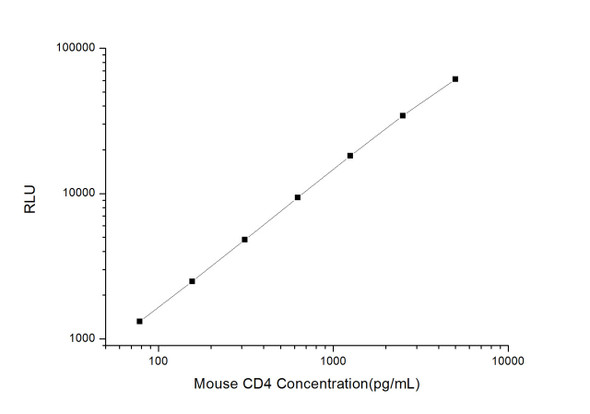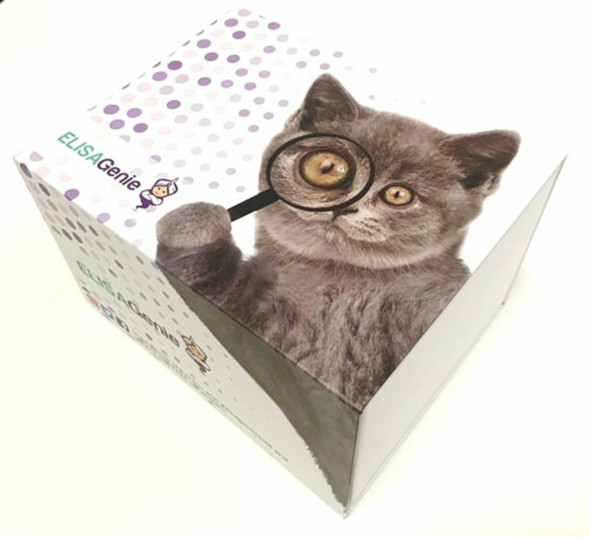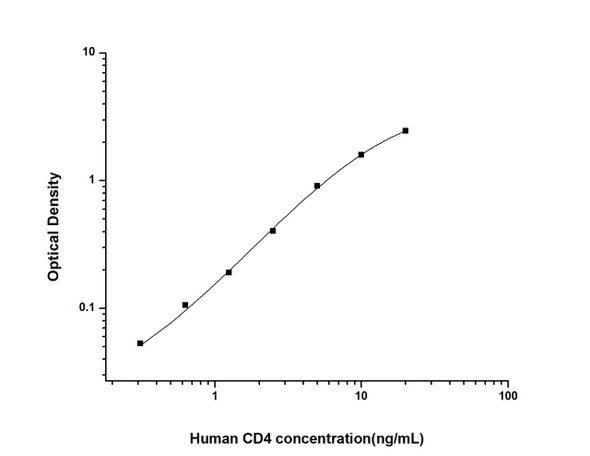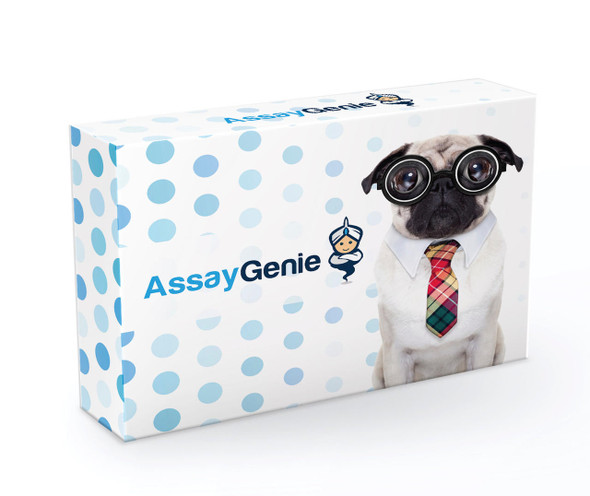Human Immunology ELISA Kits 1
Human CD4 (Cluster of Differentiation 4) CLIA Kit (HUES00471)
- SKU:
- HUES00471
- Product Type:
- ELISA Kit
- ELISA Type:
- CLIA Kit
- Size:
- 96 Assays
- Sensitivity:
- 0.56ng/mL
- Range:
- 0.94-60ng/mL
- ELISA Type:
- Sandwich
- Reactivity:
- Human
- Sample Type:
- Serum, plasma and other biological fluids
- Research Area:
- Immunology
Description
| Assay type: | Sandwich |
| Format: | 96T |
| Assay time: | 4.5h |
| Reactivity: | Human |
| Detection method: | Chemiluminescence |
| Detection range: | 0.94-60 ng/mL |
| Sensitivity: | 0.56 ng/mL |
| Sample volume: | 100µL |
| Sample type: | Serum, plasma and other biological fluids |
| Repeatability: | CV < 15% |
| Specificity: | This kit recognizes Human CD4 in samples. No significant cross-reactivity or interference between Human CD4 and analogues was observed. |
This kit uses Sandwich-CLIA as the method. The micro CLIA plate provided in this kit has been pre-coated with an antibody specific to Human CD4. Standards or samples are added to the appropriate micro CLIA plate wells and combined with the specific antibody. Then a biotinylated detection antibody specific for Human CD4 and Avidin-Horseradish Peroxidase (HRP) conjugate are added to each micro plate well successively and incubated. Free components are washed away. The substrate solution is added to each well. Only those wells that contain Human CD4, biotinylated detection antibody and Avidin-HRP conjugate will appear fluorescence. The Relative light unit (RLU) value is measured spectrophotometrically by the Chemiluminescence immunoassay analyzer. The RLU value is positively associated with the concentration of Human CD4. The concentration of Human CD4 in the samples can be calculated by comparing the RLU of the samples to the standard curve.
| UniProt Protein Function: | CD4: Accessory protein for MHC class-II antigen/T-cell receptor interaction. May regulate T-cell activation. Induces the aggregation of lipid rafts. Associates with LCK. Binds to HIV-1 gp120 and to P4HB/PDI and upon HIV-1 binding to the cell membrane, is part of P4HB/PDI- CD4-CXCR4-gp120 complex. Interacts with HIV-1 Envelope polyprotein gp160 and protein Vpu. Interacts with Human Herpes virus 7 capsid proteins. Interacts with PTK2/FAK1; this interaction requires the presence of HIV-1 gp120. |
| UniProt Protein Details: | Protein type:Membrane protein, integral; Cell surface Chromosomal Location of Human Ortholog: 12p13. 31 Cellular Component: T cell receptor complex; endoplasmic reticulum membrane; endoplasmic reticulum lumen; early endosome; plasma membrane; integral to membrane; external side of plasma membrane; lipid raft Molecular Function:protein binding; enzyme binding; transmembrane receptor activity; protein homodimerization activity; zinc ion binding; extracellular matrix structural constituent; coreceptor activity; receptor activity; glycoprotein binding; protein kinase binding; MHC class II protein binding Biological Process: maintenance of cellular protein localization; viral reproduction; positive regulation of interleukin-2 biosynthetic process; cytokine production; T cell selection; positive regulation of calcium-mediated signaling; defense response to Gram-negative bacterium; signal transduction; induction by virus of cell-cell fusion in host; T cell receptor signaling pathway; enzyme linked receptor protein signaling pathway; regulation of defense response to virus by virus; positive regulation of peptidyl-tyrosine phosphorylation; cell surface receptor linked signal transduction; positive regulation of protein kinase activity; T cell costimulation; protein palmitoleylation; innate immune response; entry into host cell; immune response; transmembrane receptor protein tyrosine kinase signaling pathway; T cell differentiation; regulation of T cell activation Disease: Okt4 Epitope Deficiency |
| NCBI Summary: | This gene encodes a membrane glycoprotein of T lymphocytes that interacts with major histocompatibility complex class II antigenes and is also a receptor for the human immunodeficiency virus. This gene is expressed not only in T lymphocytes, but also in B cells, macrophages, and granulocytes. It is also expressed in specific regions of the brain. The protein functions to initiate or augment the early phase of T-cell activation, and may function as an important mediator of indirect neuronal damage in infectious and immune-mediated diseases of the central nervous system. Multiple alternatively spliced transcript variants encoding different isoforms have been identified in this gene. [provided by RefSeq, Aug 2010] |
| UniProt Code: | P01730 |
| NCBI GenInfo Identifier: | 116013 |
| NCBI Gene ID: | 920 |
| NCBI Accession: | P01730. 1 |
| UniProt Secondary Accession: | P01730,Q4ZGK2, Q5U066, Q9UDE5, B2R737, D3DUS5, |
| UniProt Related Accession: | P01730 |
| Molecular Weight: | 458 |
| NCBI Full Name: | T-cell surface glycoprotein CD4 |
| NCBI Synonym Full Names: | CD4 molecule |
| NCBI Official Symbol: | CD4 |
| NCBI Official Synonym Symbols: | CD4mut |
| NCBI Protein Information: | T-cell surface glycoprotein CD4; CD4 receptor; CD4 antigen (p55); T-cell surface antigen T4/Leu-3 |
| UniProt Protein Name: | T-cell surface glycoprotein CD4 |
| UniProt Synonym Protein Names: | T-cell surface antigen T4/Leu-3; CD_antigen: CD4 |
| Protein Family: | CD40 ligand |
| UniProt Gene Name: | CD4 |
| UniProt Entry Name: | CD4_HUMAN |
As the RLU values of the standard curve may vary according to the conditions of the actual assay performance (e. g. operator, pipetting technique, washing technique or temperature effects), the operator should establish a standard curve for each test. Typical standard curve and data is provided below for reference only.
| Concentration (ng/mL) | RLU | Average | Corrected |
| 60 | 36173 38153 | 37163 | 37138 |
| 30 | 14556 17402 | 15979 | 15954 |
| 15 | 7941 6801 | 7371 | 7346 |
| 7.5 | 3322 3804 | 3563 | 3538 |
| 3.75 | 1856 1710 | 1783 | 1758 |
| 1.88 | 932 916 | 924 | 899 |
| 0.94 | 492 512 | 502 | 477 |
| 0 | 24 26 | 25 | -- |
Precision
Intra-assay Precision (Precision within an assay): 3 samples with low, mid range and high level Human CD4 were tested 20 times on one plate, respectively.
Inter-assay Precision (Precision between assays): 3 samples with low, mid range and high level Human CD4 were tested on 3 different plates, 20 replicates in each plate.
| Intra-assay Precision | Inter-assay Precision | |||||
| Sample | 1 | 2 | 3 | 1 | 2 | 3 |
| n | 20 | 20 | 20 | 20 | 20 | 20 |
| Mean (ng/mL) | 3.31 | 5.61 | 26.06 | 3.57 | 5.71 | 24.07 |
| Standard deviation | 0.33 | 0.62 | 2.56 | 0.33 | 0.52 | 2.48 |
| C V (%) | 9.97 | 11.05 | 9.82 | 9.24 | 9.11 | 10.30 |
Recovery
The recovery of Human CD4 spiked at three different levels in samples throughout the range of the assay was evaluated in various matrices.
| Sample Type | Range (%) | Average Recovery (%) |
| Serum (n=5) | 84-97 | 91 |
| EDTA plasma (n=5) | 85-100 | 92 |
| Cell culture media (n=5) | 91-107 | 98 |
Linearity
Samples were spiked with high concentrations of Human CD4 and diluted with Reference Standard & Sample Diluent to produce samples with values within the range of the assay.
| Serum (n=5) | EDTA plasma (n=5) | Cell culture media (n=5) | ||
| 1:2 | Range (%) | 87-104 | 88-99 | 94-107 |
| Average (%) | 95 | 93 | 102 | |
| 1:4 | Range (%) | 92-104 | 87-98 | 94-110 |
| Average (%) | 97 | 92 | 101 | |
| 1:8 | Range (%) | 88-103 | 98-111 | 87-98 |
| Average (%) | 95 | 105 | 93 | |
| 1:16 | Range (%) | 102-118 | 90-102 | 101-116 |
| Average (%) | 109 | 95 | 109 |
An unopened kit can be stored at 4°C for 1 month. If the kit is not used within 1 month, store the items separately according to the following conditions once the kit is received.
| Item | Specifications | Storage |
| Micro CLIA Plate(Dismountable) | 8 wells ×12 strips | -20°C, 6 months |
| Reference Standard | 2 vials | |
| Concentrated Biotinylated Detection Ab (100×) | 1 vial, 120 µL | |
| Concentrated HRP Conjugate (100×) | 1 vial, 120 µL | -20°C(shading light), 6 months |
| Reference Standard & Sample Diluent | 1 vial, 20 mL | 4°C, 6 months |
| Biotinylated Detection Ab Diluent | 1 vial, 14 mL | |
| HRP Conjugate Diluent | 1 vial, 14 mL | |
| Concentrated Wash Buffer (25×) | 1 vial, 30 mL | |
| Substrate Reagent A | 1 vial, 5 mL | 4°C (shading light) |
| Substrate Reagent B | 1 vial, 5 mL | 4°C (shading light) |
| Plate Sealer | 5 pieces | |
| Product Description | 1 copy | |
| Certificate of Analysis | 1 copy |
- Set standard, test sample and control (zero) wells on the pre-coated plate and record theirpositions. It is recommended to measure each standard and sample in duplicate. Note: addall solutions to the bottom of the plate wells while avoiding contact with the well walls. Ensuresolutions do not foam when adding to the wells.
- Aliquot 100µl of standard solutions into the standard wells.
- Add 100µl of Sample / Standard dilution buffer into the control (zero) well.
- Add 100µl of properly diluted sample (serum, plasma, tissue homogenates and otherbiological fluids. ) into test sample wells.
- Cover the plate with the sealer provided in the kit and incubate for 90 min at 37°C.
- Aspirate the liquid from each well, do not wash. Immediately add 100µL of BiotinylatedDetection Ab working solution to each well. Cover the plate with a plate seal and gently mix. Incubate for 1 hour at 37°C.
- Aspirate or decant the solution from the plate and add 350µL of wash buffer to each welland incubate for 1-2 minutes at room temperature. Aspirate the solution from each well andclap the plate on absorbent filter paper to dry. Repeat this process 3 times. Note: a microplatewasher can be used in this step and other wash steps.
- Add 100µL of HRP Conjugate working solution to each well. Cover with a plate seal andincubate for 30 min at 37°C.
- Aspirate or decant the solution from each well. Repeat the wash process for five times asconducted in step 7.
- Add 100µL of Substrate mixture solution to each well. Cover with a new plate seal andincubate for no more than 5 min at 37°C. Protect the plate from light.
- Determine the RLU value of each well immediately.






